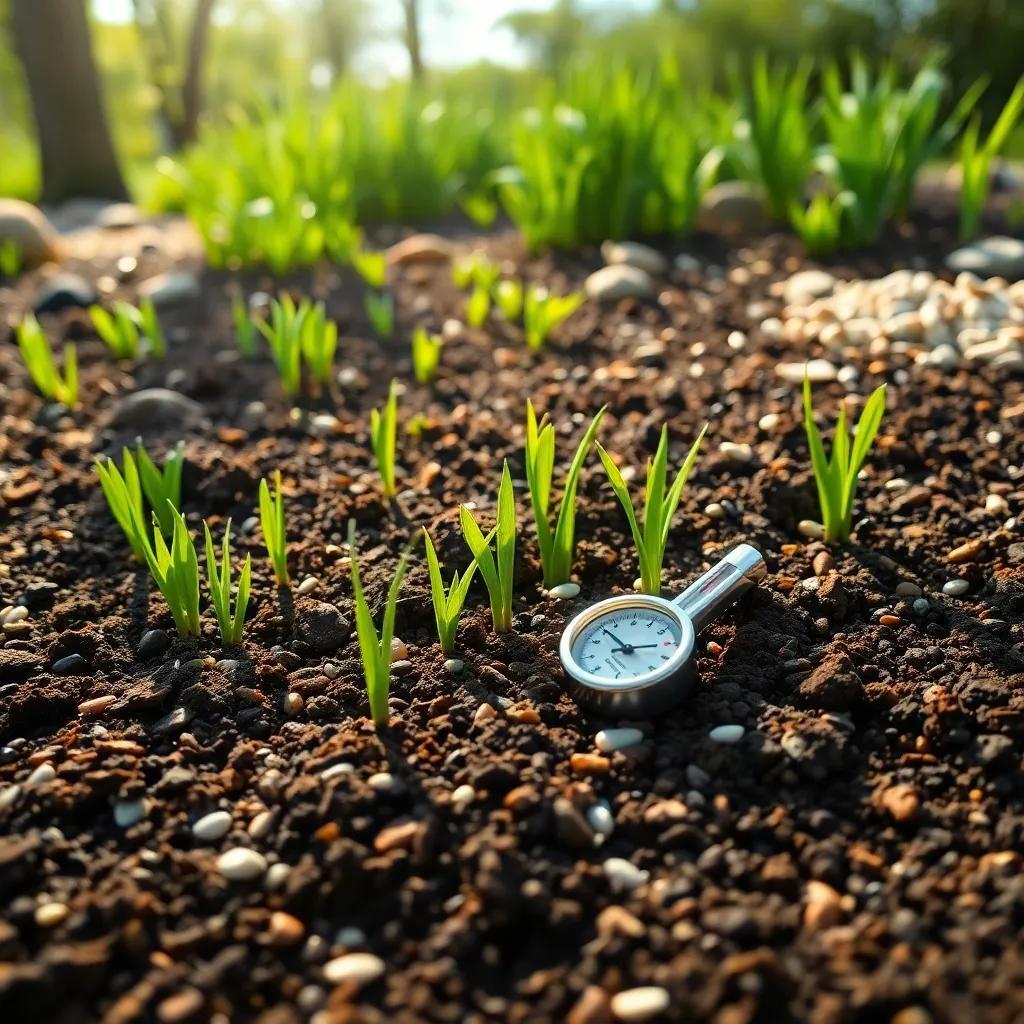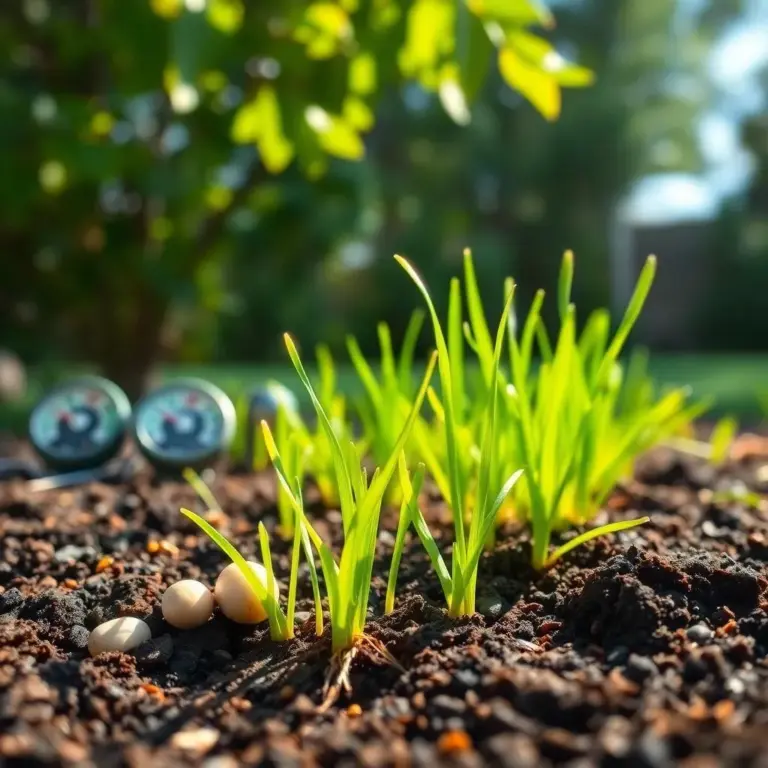Are you ready to transform your yard into a lush paradise? Growing rye grass can be a fun and rewarding journey, and I’m here to share everything you need to know! From understanding how long it takes for those tiny seeds to sprout to tackling common challenges, this guide is packed with tips that will help you achieve the vibrant lawn of your dreams!
Factors Influencing Rye Grass Germination Time
When it comes to getting that lush rye grass lawn you dream of, several factors play a big role in how quickly those little seeds sprout! Germination time can vary from 5 to 10 days, but don’t worry—knowing what impacts this can help you get the most out of your efforts.
- Soil Temperature: Rye grass loves cooler weather! The best soil temperatures for germination are between 50°F (10°C) and 65°F (18°C). If the soil is too cold, the seeds might take a nap instead of sprouting. On the flip side, if it gets too warm, your seeds may not thrive either. It’s like they need just the right blanket!
- Moisture Level: Think of water as the magic potion for rye grass seeds. They need enough water to wake up and grow, but too much water can cause them to drown! Keeping the soil evenly moist—not soaking—is key. Regular watering will help your seeds drink up just enough to sprout.
- Seed Quality: You wouldn’t make a cake with old flour, would you? The same goes for seeds! Using high-quality rye grass seeds ensures a better chance of successful germination. Always check the label for freshness and viability.
- Seedbed Preparation: A well-prepped seedbed makes all the difference! Clear away any weeds, rocks, or debris to give your seeds a clear shot at success. Loosen the soil to help the seeds get cozy and make contact with the ground.
- Seed Depth: How deep should you plant those seeds? The sweet spot is about ¼ to ½ inch (6 to 13 mm) deep. Planting them too deep can make it tough for them to push through the soil, while planting them too shallow can lead to drying out.
By keeping these factors in mind, you’re setting the stage for a successful rye grass germination process. Soon enough, you’ll have that dreamy green lawn to enjoy!
Creating Ideal Conditions for Quick Germination
Alright, now that we know what factors can influence rye grass germination, let’s talk about how to create those ideal conditions for your seeds! Getting everything right can mean the difference between a patchy lawn and a green carpet that makes your neighbors jealous!
- Soil pH: Rye grass prefers a soil pH between 6.0 and 7.0. This means your soil should be slightly acidic to neutral. A simple soil test can tell you what needs adjusting. Don’t worry; you can usually fix pH issues with some amendments!
- Consistent Moisture: Just like keeping a cake batter moist is key to a delicious cake, keeping your soil moist is vital for your rye grass. Water the area regularly to maintain an even moisture level. If Mother Nature is on your side, great! If not, you’ll need to lend a hand!
- Temperature Maintenance: Timing is everything! Plant your rye grass seeds when the temperatures are just right. You can also monitor the soil with a thermometer to ensure it’s cozy enough for your little seeds.
- Sunlight Exposure: Rye grass seeds are like kids in a candy store—they love the light! If possible, don’t bury them too deep. A little sunlight goes a long way in helping them sprout.
- Air Circulation: Last but not least, give your grass some breathing room! Make sure there’s good airflow around the seeded area. This helps avoid moisture traps that might lead to fungal diseases.
By following these simple tips, you can create a welcoming environment for your rye grass to thrive! I can’t wait for you to see those beautiful green shoots popping up. Happy gardening!

Understanding the Rye Grass Germination Process
Now that we’ve covered the factors that influence rye grass germination and how to create ideal conditions, let’s dive into the germination process itself! It’s like watching a magic show, where those tiny seeds transform into green wonders.
- Imbibition Phase (Days 1-2): After you sow the seeds, they begin soaking up water. This phase is called imbibition. The seeds swell as they absorb moisture, and it’s like they’re waking up from a long nap! You won’t see much happening just yet, but trust me, exciting things are happening beneath the surface.
- Root Development (Days 3-5): By the third day, the seeds are ready to stretch their roots! Tiny, white roots called radicles will emerge and dig down into the soil to soak up nutrients. This is when you can start to get a little giddy because the first signs of life are on their way!
- Shoot Emergence (Days 6-10): As the days roll on, those roots continue to grow, and soon, you’ll see the first green shoots poking through the soil. These little beauties, known as cotyledons, are essential for the seedlings—they help provide energy until the true leaves appear. And voila, you have grass!
- Establishment Phase (After Day 10): Once the true leaves start to grow, your rye grass is entering a new stage of life. It’s gaining strength and preparing to become the lush lawn you’ve been dreaming of! By this point, it will need regular care to flourish.
Understanding this process helps me appreciate all the hard work those seeds are putting in. Just think about it, all that growth is happening while we wait!
Tips for Successful Rye Grass Seed Establishment
After those little seeds have done their magic, it’s time for me to roll up my sleeves and help them grow into a beautiful lawn! Here are some tips I’ve gathered that can make all the difference in establishing strong rye grass:
- Prepare the Seedbed: A good start makes a significant impact! I like to ensure the seedbed is free of debris and weeds. Loosen the soil to create a fluffy bed for my seeds to snuggle into, giving them the best chance of success.
- Correct Sowing Depth: Timing is everything, and so is depth! I make sure to plant my seeds about ¼ to ½ inch (6 to 13 mm) deep. This depth helps protect them from drying out while still allowing them to emerge easily.
- Water, Water, Water! I keep the soil consistently moist, especially during germination. It’s like giving my seeds a refreshing drink! I water them regularly, but I’m careful not to overdo it. Nobody likes soggy soil!
- Monitor Temperature: Keeping an eye on the temperature is essential. If it’s too hot, I might provide some shade. Conversely, if it’s chilly, I wait for the sun to warm the soil just right!
- Fertilize Wisely: Once my seeds are up and running, I give them a nutrient boost! A slow-release fertilizer designed for new grass seedlings helps them grow strong and healthy.
Following these tips helps me feel confident that my rye grass will thrive. It’s rewarding to see those vibrant green shoots grow tall and proud!
Common Challenges in Rye Grass Germination
While growing rye grass can be a joyous journey, like any adventure, there can be bumps in the road. Here are some common challenges I’ve encountered while trying to get my grass to germinate, along with ways to overcome them:
- Poor Seed Quality: Not all seeds are created equal! If I use old or low-quality seeds, they might not sprout. I always check the germination rates on the packaging and choose fresh, reputable seeds to avoid disappointment.
- Timing and Temperature Blues: Timing is everything! If I plant too early in the season when the soil is still too cold, or when it’s scorching hot, my seeds could struggle. I always try to wait for that sweet spot of cool weather!
- Moisture Mismanagement: Water is the lifeblood of my grass, but too much can be a problem! I monitor the soil moisture closely. If it’s too dry, I water; if it’s too soggy, I ease up on the watering. Finding that perfect balance is vital!
- Seed Depth Dilemmas: Planting seeds too deep or too shallow can lead to trouble. I make sure to stick to that ¼ to ½ inch (6 to 13 mm) depth. It’s all about giving them a fighting chance!
- Weed Wars: Weeds are like uninvited guests—they love to crash the party! I always tackle them before seeding and keep an eye on them as my rye grass grows to ensure they don’t steal nutrients or sunlight.
By being aware of these potential challenges, I can tackle them head-on and help my rye grass thrive. With some patience and care, I know I’ll be rewarded with a stunning lawn! Happy gardening!

